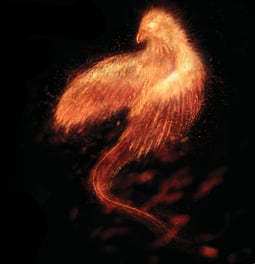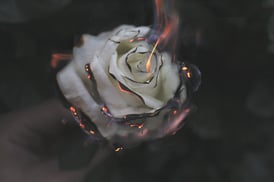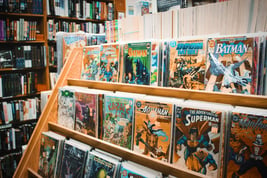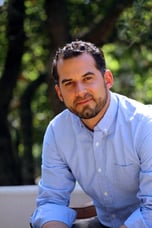Phoenix Force and Feminine Jouissance: Reading Myth in Comic Books and Pop Culture. Interview with David M. Odorisio, Ph.D. A Guest Blog Post by Devon Deimler, Ph.D.c.
 You began forming your Joseph Campbell Round Table presentation last Fall (2017). We had to postpone the event due to the Thomas Fire and subsequent mudslides. Of course, the mythical phoenix cyclically burns and rises from ashes. What first drew you to the phoenix myth/X-Men character and how has your relationship with it/her transformed after experiencing a wildfire?
You began forming your Joseph Campbell Round Table presentation last Fall (2017). We had to postpone the event due to the Thomas Fire and subsequent mudslides. Of course, the mythical phoenix cyclically burns and rises from ashes. What first drew you to the phoenix myth/X-Men character and how has your relationship with it/her transformed after experiencing a wildfire?
My plan was to spend the month of December preparing for the January presentation. This was after spending the past year immersed in the Phoenix material and almost obsessively researching every X-Men storyline that involved, referenced, or developed her or her daughter’s character (another Phoenix). I live in a small house in the Toro Canyon area of Santa Barbara County, which became one of the heaviest and prolonged fire-fighting areas during the Thomas Fire. The fire was progressing closer and closer to the County line, and spreading to my surrounding area as I was literally putting together the presentation. At one point it was raining ash on my neighborhood. My yard was a blanket of snowy white ash. The visibility was maybe 10-15 ft. and the air quality outdoors was terrible – pure smoke. Here I am, spending hours indoors each day at work on this research, immersed in images of a fiery female figure and here She is right at my front door. I reached a point where I had to pause and ask, “Am I invoking this?” Of course it wasn’t personal, but it was personal at the same time, because I’m internalizing and making my own meaning from the experience as we all have for those of us who have lived through it.
So the fire was deeply personal, in a very ‘life or death’ way. But the immediacy of the fire and evacuations forced me to step away from the material for a while, which turned out to be many months, due to the debris flow, and in that time, a lot changed for me. When I first started reading the Phoenix material, I was captivated, completely drawn into it. Jungians might call it an “anima complex” or fixation. I was fascinated by her. It was a total transference – completely numinous material for me. She was an aspect of myself that was appearing in all of my personal relationships and yet I was not able to integrate in myself. So I did what all good “wounded researchers” do: I read. I read her until she became me, or at least until I could better see myself in her. So what the fire did for me (among many other things) was to both terrifyingly “incarnate” her through this awful lived experience, and then subsequently enforce a certain distance as well – which meant a certain distance from the material, which was ultimately beneficial. I was getting too close to the material and couldn’t “see” it. It was too “hot.” The reality of the fire, and the life-or-death nature of “get out” – I mean, the Sheriff’s department was at my front door at 4 am – it created an overwhelming sense of the fragility of life. I was living the material that I was so immersed in. The entire experience was incredibly humbling. To come that close to facing the reality of my own mortality, while also being so intensely involved in researching this archetypal force of nature – this regenerative Fire – which at that point was only manifesting its “terrible” and destructive side. And all this after spending the last few years writing and publishing on the Hindu goddess Kālī. But that is another story!
.jpg?width=276&height=184&name=VIRTUAL%20INFORMATION%20SESSION%20(3).jpg) Your topic has come to feel rather prescient in another way as well. Over the past several months, long-silenced voices of sexually abused people, overwhelmingly women, have risen up, and patriarchal norms destructive to so many are now facing significant destruction themselves. Can you speak to the “feminine jouissance” of this moment?
Your topic has come to feel rather prescient in another way as well. Over the past several months, long-silenced voices of sexually abused people, overwhelmingly women, have risen up, and patriarchal norms destructive to so many are now facing significant destruction themselves. Can you speak to the “feminine jouissance” of this moment?
Yes, I think this is part of the “regenerative” nature of Fire. And yet it only comes after intense, and in this case prolonged, destruction/deconstruction, which we are most definitely still “in.” We are seeing this in so many arenas: political, cultural, social, environmental. Unexamined whiteness, masculinist ideology, heteronormative policy making, not to mention outright misogyny and racism at all levels are on stage in a very, very public way. Social media has played an important role in “giving witness” to these larger cultural shadows much in the same way television afforded Americans across the country awareness of what was occurring for Southern black folk during the de-segregation protests in the 1960s. “We Stay Woke” is an important signifier because it is about staying awake, i.e. becoming conscious, of the “dark side” of America’s cultural complexes. This country has a deeply wounded history, and at this moment, in this “dark time,” we are all learning “how to see” (to invoke the poet Roethke). Whether one likes what he or she sees “upon waking” is an entirely different discussion.
Patriarchal forms of masculinity are currently undergoing a very prolonged, painful, and public deconstructive death, and since we have a few hundred years of such policy-making and ideology embedded in our cultural psyche, it is going to continue to take a very long time for something new or alternative to emerge. To me, however, this is precisely where jouissance erupts. To Lacan, jouissance is something at the margins, just beyond the edge of a boundary, limitation, or even death, and is therefore outside the realm of “the known,” which in his (and Jung’s) psychology is a masculine orientation to the world, represented by Logos. Jouissance represents the Erotic function, which Lacan casts as “feminine,” and constitutes embodiment, subjectivity, and sexuality – all aspects of the psyche traditionally relegated to “the feminine” and denigrated in a typical patriarchal, Western paradigm and projected onto “Woman.” But feminine jouissance breaks through this, and has the ability to penetrate narcissistic and toxic forms of masculinity. Eros can neither be contained nor reduced by contemporary forms of phallogocentrism (Derrida’s term for masculinist ideology). This is also at the core of the #MeToo movement – it is not only about breaking the terrible silence around male perpetration and sexual abuse. It has also become about women claiming and celebrating their own creative and sexual self-agency.
 This is also where the comic books piece comes in. One of the strands that emerged from my reading of the Phoenix character throughout her decades of male authorship and illustration is the way in which she transforms – and “performs” – depending on who is writing her. In other words, Phoenix, a female character, is authored and comes to life via male fantasy. And yet, as Dark Phoenix she emerges as a symbol of resistance – often to patriarchy, and any forms of “order” and “structure” that seek to contain her. Phoenix’s jouissance in this capacity, especially during the Chris Claremont run of the “Dark Phoenix Saga,” is extraordinary, fearsome, and often terribly destructive through its insatiability (another male fantasy of female sexuality), yet remains liberatingly “free.” So you have this character who – on one hand – functions along the lines of a typical heteronormative male fantasy; and yet at the same time subverts and continuously undermines these same structures (as Dark Phoenix) even as she also falls into and struggles with them (as Jean Grey). So there is this incredible character development that plays out the personal and the archetypal in complex ways. This became for me one of the most fascinating pieces of what turned into a highly investigative project colored by a combined depth psychological/feminist/post-structural reading, and a culturally sensitive and sociologically textured lens. I was deeply informed by the excellent studies of Ramzi Fawaz (The New Mutants), and of course Jeff Kripal’s Mutants and Mystics. Both of these are required reading for the course I’ll be teaching next Winter (2019) in Pacifica’s Mythological Studies graduate program.
This is also where the comic books piece comes in. One of the strands that emerged from my reading of the Phoenix character throughout her decades of male authorship and illustration is the way in which she transforms – and “performs” – depending on who is writing her. In other words, Phoenix, a female character, is authored and comes to life via male fantasy. And yet, as Dark Phoenix she emerges as a symbol of resistance – often to patriarchy, and any forms of “order” and “structure” that seek to contain her. Phoenix’s jouissance in this capacity, especially during the Chris Claremont run of the “Dark Phoenix Saga,” is extraordinary, fearsome, and often terribly destructive through its insatiability (another male fantasy of female sexuality), yet remains liberatingly “free.” So you have this character who – on one hand – functions along the lines of a typical heteronormative male fantasy; and yet at the same time subverts and continuously undermines these same structures (as Dark Phoenix) even as she also falls into and struggles with them (as Jean Grey). So there is this incredible character development that plays out the personal and the archetypal in complex ways. This became for me one of the most fascinating pieces of what turned into a highly investigative project colored by a combined depth psychological/feminist/post-structural reading, and a culturally sensitive and sociologically textured lens. I was deeply informed by the excellent studies of Ramzi Fawaz (The New Mutants), and of course Jeff Kripal’s Mutants and Mystics. Both of these are required reading for the course I’ll be teaching next Winter (2019) in Pacifica’s Mythological Studies graduate program.
Comics seem to provide a unique medium for exploring the mythic imagination. As a visual/literary medium, they exercise the imagination aesthetically. Many comics span decades, developing complex internal histories and expanding the emotional imagination through deeply cultivated bonds to heroes and villains. They also engage the critical imagination in comparative work between comics and the world (the real via the unreal and vice versa). All of these are mythic functions. How else might you demonstrate comics as modern myths?
It’s important for me as a scholar of religion to develop a “tool box” of “reading glasses.” What I mean by this is to consciously cultivate different perspectives of how to read the material in front of me (whether it’s a written, visual or oral “text”). This is the crux of the hermeneutic situation. What lens to view which situation and why? The course next Winter will really delve into this “creative problem,” but will focus mainly on a variety of cultural, historical, and of course depth psychological readings of comics-as-myths (which is an assumed hermeneutic stance in and of itself). Regarding imagination, though, one of the inspirations I drew from Jeff Kripal’s work is his research into “left/right” hemisphere thinking and how comic books encourage the brain to “link up” and offer rare opportunities for both “halves” of the brain to work synchronously. Kripal takes this further and speculates that perhaps this linkage might work to create anomalous or even revelatory spiritual experiences; hence his conclusion that comic books and popular culture serve as fitting mediums to “encode” certain “gnostic” epiphanies – since the medium serves so well as a “conductor” for such experiences. So that is the more esoteric piece. The other is the mythological function of storytelling and speaks to the title of Chris Knowles’ book Our Gods Wear Spandex. Do they? Are comic books a re-telling of past myths or archaic, “archetypal” material dressed in modern/futuristic clothing? I don’t have any hard and fast answers to these questions, but I do know from my own experiences that there is a numinous quality to the art and symbolism in which comic books are built on, many of which intentionally (or unintentionally) draw from millennia of mythological and religious materials. These are some of the points and frames of reference we are going to explore in the course next year.
Movies based on superhero comics have been owning the box office for some years now. These movies are often cited in our field as a kind of archetypal “return” of myth to the popular imagination. I am not as readily sold on that general claim (or fantasy) as I perhaps should be, but I’ve also felt its truth on a few occasions. What films do you feel are most successful in re-imagining a comic character, plot, etc. as a modern mythos and why?
This is a challenging question, and a hermeneutic one as well, since all comic books ultimately need to pass through the individual and collective psyches of scriptwriters and come out, well, different. Then there is the reality of certain cultural complexes coming into play, too (Hollywood being one of the major “projectors” of the unconscious). This is a piece of what makes the study of pop culture so fascinating to me – how it helps us read ourselves back onto ourselves, reflected back by the “silver screen.” So to return to your question, I think those films that are most successful operate in this self-reflective capacity. The challenge, though, and role of the cultural critic or the depth social psychologist is to examine precisely what it is that is being reflected back, and what are the cultural norms that are dictating the film in the first place. Wonder Woman, for example, powerfully portrays a strong female protagonist and was hugely successful in the box office; however, if we adopt a critical/queer reading, it can easily become another heteronormative fantasy. How would the film have performed without the male romantic plotline? Why couldn’t she have “saved the day” as an empowered woman on her own? Is that really what women are saying right now? It felt against the spirit of the times – like the film missed an opportunity to say or provoke some serious questions about gender roles. I felt similarly about Black Panther. It was a visually stunning celebration of African culture, and provided a much-needed portrayal of black women and men in positions of authority – especially governmental. But I felt that the film invested so much in the entertainment factor that it missed the opportunity to create some discussion around questions of race in America.

But the why question still remains. Why the blockbuster impact of superhero stories? Why now? Something is being sparked in the cultural psyche that perhaps desires these types of stories of mythic proportions (think Harry Potter and Lord of the Rings as well). Why is that? Part of it is, I believe, the current postmodern situation, and what is perhaps a human need for a “personal myth,” with film stepping into the lacunae that was once filled by religion. I think a piece of it is this human need to construct coherent, cohesive, and compelling narratives around perennial questions of meaning and existence that need to be imagined and re-imagined continually – only for subsequent generations to ask – and answer – these questions anew (for example, the multi-generational and evolving Star Wars enterprise). One over-arching theme, however – one that deeply disturbs me – is that in nearly every single one of the superhero stories, it is a good vs. evil mythos that ultimately ends with the destruction of the “bad guys” overcome by the “good guys (or girls).” Only Star Wars comes close to transcending this with the aim to “balance the force” – but in the end the tendency is always to eradicate evil. Given our current highly polarized political situation (nationally and internationally) this disturbs me greatly. It seems as if the Western, American psyche is still not ready to integrate the shadow. This is why we need mythologists, cultural critics, and depth psychologists who are not afraid to read the cultural signs of the times through emerging literature, film, and popular culture and serve as not only commentators or academic hermeneuts, but also as creators and contributors of their own unique “storyboards” and modern myths as well.
Learn more about the Mythological Studies program at Pacifica.
Join The Joseph Campbell Foundation Mythological RoundTable® Group of OPUS at Pacifica Graduate Institute for the upcoming free event, “Phoenix Force and Feminine Jouissance: Reading Myth in Comic Books and Pop Culture” featuring David M. Odorisio, PhD. Click to learn more.
 David M. Odorisio, PhD, serves as Director of The Retreat at Pacifica Graduate Institute, Santa Barbara, California, and is Adjunct Faculty in Pacifica’s Mythological Studies graduate degree program. David received his PhD in East-West Psychology from the California Institute of Integral Studies and teaches in the areas of methodology, psychology and religion, and comparative mysticism. He is co-editor of the forthcoming volume Depth Psychology and Mysticism (Palgrave Macmillan) and has published in a variety of journals, including: Quadrant: Journal of the C.G. Jung Foundation for Analytical Psychology, Jung Journal, Philosophy East and West, The Journal of Transpersonal Psychology, and The International Journal of Transpersonal Studies, among others. www.ahomeforsoul.com.
David M. Odorisio, PhD, serves as Director of The Retreat at Pacifica Graduate Institute, Santa Barbara, California, and is Adjunct Faculty in Pacifica’s Mythological Studies graduate degree program. David received his PhD in East-West Psychology from the California Institute of Integral Studies and teaches in the areas of methodology, psychology and religion, and comparative mysticism. He is co-editor of the forthcoming volume Depth Psychology and Mysticism (Palgrave Macmillan) and has published in a variety of journals, including: Quadrant: Journal of the C.G. Jung Foundation for Analytical Psychology, Jung Journal, Philosophy East and West, The Journal of Transpersonal Psychology, and The International Journal of Transpersonal Studies, among others. www.ahomeforsoul.com.
 Devon Deimler, PhDc, is Curatorial Assistant at OPUS Archives and Research Center, as well as Leader of the Joseph Campbell Foundation Mythological RoundTable® Group of OPUS. Devon is currently a PhD Candidate in Mythological Studies with an Emphasis in Depth Psychology at Pacifica Graduate Institute where she is completing a dissertation entitled Ultraviolet Concrete: Dionysos and the Ecstatic Play of Aesthetic Experience. Before studying at Pacifica, Devon received her BA in Interdisciplinary Sculpture from the Maryland Institute College of Art in Baltimore, focusing on event-based work and modern through contemporary art and film history. Her experience in art and music includes founding an independent record label and collaborative event project, Wildfire Wildfire Productions, and working as Assistant to the Director at the Dennis Hopper Art Trust in Los Angeles.
Devon Deimler, PhDc, is Curatorial Assistant at OPUS Archives and Research Center, as well as Leader of the Joseph Campbell Foundation Mythological RoundTable® Group of OPUS. Devon is currently a PhD Candidate in Mythological Studies with an Emphasis in Depth Psychology at Pacifica Graduate Institute where she is completing a dissertation entitled Ultraviolet Concrete: Dionysos and the Ecstatic Play of Aesthetic Experience. Before studying at Pacifica, Devon received her BA in Interdisciplinary Sculpture from the Maryland Institute College of Art in Baltimore, focusing on event-based work and modern through contemporary art and film history. Her experience in art and music includes founding an independent record label and collaborative event project, Wildfire Wildfire Productions, and working as Assistant to the Director at the Dennis Hopper Art Trust in Los Angeles.



